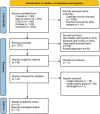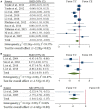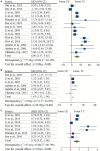The comparison between effects of Taichi and conventional exercise on functional mobility and balance in healthy older adults: a systematic literature review and meta-analysis
- PMID: 38164444
- PMCID: PMC10757983
- DOI: 10.3389/fpubh.2023.1281144
The comparison between effects of Taichi and conventional exercise on functional mobility and balance in healthy older adults: a systematic literature review and meta-analysis
Abstract
Background: Taichi is beneficial for functional mobility and balance in older adults. However, such benefits of Taichi when comparing to conventional exercise (CE) are not well understood due to large variance in study protocols and observations.
Methods: We reviewed publications in five databases. Eligible studies that examined the effects of Taichi on the outcomes of functional mobility and balance in healthy older adults as compared to CE were included. Subgroup analyses compared the effects of different types of CE (e.g., single and multiple-type exercise) and different intervention designs (e.g., Taichi types) on those outcomes (Registration number: CRD42022331956).
Results: Twelve studies consisting of 2,901 participants were included. Generally, compared to CE, Taichi induced greater improvements in the performance of Timed-Up-and-Go (SMD = -0.18, [-0.33 to -0.03], p = 0.040, I2 = 59.57%), 50-foot walking (MD = -1.84 s, [-2.62 to -1.07], p < 0.001, I2 = 0%), one-leg stance with eyes open (MD = 6.00s, [2.97 to 9.02], p < 0.001, I2 = 83.19%), one-leg stance with eyes closed (MD = 1.65 s, [1.35 to 1.96], p < 0.001, I2 = 36.2%), and functional reach (SMD = 0.7, [0.32 to 1.08], p < 0.001, I2 = 86.79%) tests. Subgroup analyses revealed that Taichi with relatively short duration (<20 weeks), low total time (≤24 h), and/or using Yang-style, can induce significantly greater benefits for functional mobility and balance as compared to CE. Uniquely, Taichi only induced significantly greater improvements in Timed-Up-and-Go compared to single- (SMD = -0.40, [-0.55 to -0.24], p < 0.001, I2 = 6.14%), but not multiple-type exercise. A significant difference between the effects of Taichi was observed on the performance of one-leg stance with eyes open when compared to CE without balance (MD = 3.63 s, [1.02 to 6.24], p = 0.006, I2 = 74.93%) and CE with balance (MD = 13.90s, [10.32 to 17.48], p < 0.001, I2 = 6.1%). No other significant difference was shown between the influences of different CE types on the observations.
Conclusion: Taichi can induce greater improvement in functional mobility and balance in older adults compared to CE in a more efficient fashion, especially compared to single-type CE. Future studies with more rigorous design are needed to confirm the observations here.
Keywords: Taichi; balance; exercise prescription; functional mobility; older adults; protocol design; rehabilitative programs.
Copyright © 2023 Li, Liu, Zhou, Dong, Manor, Bao and Zhou.
Conflict of interest statement
The authors declare that the research was conducted in the absence of any commercial or financial relationships that could be construed as a potential conflict of interest.
Figures
Similar articles
-
Tai chi improves balance performance in healthy older adults: a systematic review and meta-analysis.Front Public Health. 2024 Nov 11;12:1443168. doi: 10.3389/fpubh.2024.1443168. eCollection 2024. Front Public Health. 2024. PMID: 39588165 Free PMC article.
-
The effect of Tai Chi on balance and functional mobility in children with congenital sensorineural hearing loss.Disabil Rehabil. 2020 Jun;42(12):1736-1743. doi: 10.1080/09638288.2018.1535629. Epub 2019 Jan 9. Disabil Rehabil. 2020. PMID: 30623683
-
Tai Chi for fall prevention and balance improvement in older adults: a systematic review and meta-analysis of randomized controlled trials.Front Public Health. 2023 Sep 1;11:1236050. doi: 10.3389/fpubh.2023.1236050. eCollection 2023. Front Public Health. 2023. PMID: 37736087 Free PMC article.
-
Is Virtual Reality Training More Effective Than Traditional Physical Training on Balance and Functional Mobility in Healthy Older Adults? A Systematic Review and Meta-Analysis.Front Hum Neurosci. 2022 Mar 23;16:843481. doi: 10.3389/fnhum.2022.843481. eCollection 2022. Front Hum Neurosci. 2022. PMID: 35399351 Free PMC article.
-
Effects of Virtual Reality Training (Exergaming) Compared to Alternative Exercise Training and Passive Control on Standing Balance and Functional Mobility in Healthy Community-Dwelling Seniors: A Meta-Analytical Review.Sports Med. 2016 Sep;46(9):1293-309. doi: 10.1007/s40279-016-0485-1. Sports Med. 2016. PMID: 26886474 Review.
Cited by
-
Effectiveness of Tai Chi exercise on balance, falls, and motor function in older adults: a meta-analysis.Front Med (Lausanne). 2024 Nov 5;11:1486746. doi: 10.3389/fmed.2024.1486746. eCollection 2024. Front Med (Lausanne). 2024. PMID: 39564508 Free PMC article.
-
Tai chi improves balance performance in healthy older adults: a systematic review and meta-analysis.Front Public Health. 2024 Nov 11;12:1443168. doi: 10.3389/fpubh.2024.1443168. eCollection 2024. Front Public Health. 2024. PMID: 39588165 Free PMC article.
-
Sensor-Based Gait and Balance Assessment in Healthy Adults: Analysis of Short-Term Training and Sensor Placement Effects.Sensors (Basel). 2024 Aug 29;24(17):5598. doi: 10.3390/s24175598. Sensors (Basel). 2024. PMID: 39275509 Free PMC article.
-
The Science of Tai Chi and Qigong as Whole Person Health-Part I: Rationale and State of the Science.J Integr Complement Med. 2025 Jun;31(6):499-520. doi: 10.1089/jicm.2024.0957. Epub 2025 Mar 17. J Integr Complement Med. 2025. PMID: 40091656 Review.
-
Exercise therapy: an effective approach to mitigate the risk of cancer metastasis.World J Surg Oncol. 2025 May 16;23(1):192. doi: 10.1186/s12957-025-03846-7. World J Surg Oncol. 2025. PMID: 40380237 Free PMC article. Review.
References
Publication types
MeSH terms
LinkOut - more resources
Full Text Sources




